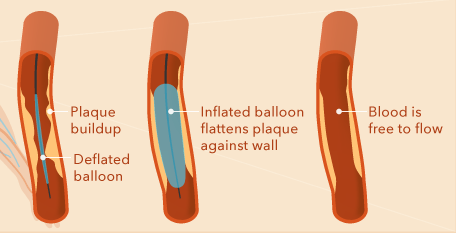Coronary Angioplasty
Best Angioplasty Doctor in Pune - Dr. Kedar Kulkarni
The best angioplasty doctor in Pune will perform a procedure known as coronary angioplasty, which opens up narrowed or blocked coronary arteries (the main blood vessels supplying the heart).
What is Coronary Angioplasty?
The word “angioplasty” refers to a procedure in which a balloon is used to stretch a narrowed or blocked artery open. However, most current angioplasty procedures also include the insertion of a narrow wire-mesh tube into the artery, known as a stent. To allow blood to flow more freely, the stent is left in place indefinitely.
Percutaneous transluminal coronary angioplasty (PTCA) is another name for coronary angioplasty. Percutaneous coronary intervention (PCI) is the term used to describe the combination of coronary angioplasty and stenting.

When a coronary angioplasty is used
How a coronary angioplasty is performed
A coronary angioplasty is mostly done under local anaesthesia, so you may be conscious during the operation.
Via an incision in your groyne, wrist, or arm, a thin flexible tube called a catheter will be inserted into one of your arteries. Using an X-ray film, this is directed to the affected coronary artery.
A thin wire is directed down the length of the affected coronary artery with the catheter in place, carrying a small balloon to the affected part of the artery. When the deflated balloon is removed, it widens the artery by squashing fatty deposits against the artery wall, allowing blood to flow more freely.
If a stent is used, it will be wrapped around the balloon before insertion. When the balloon is inflated, the stent expands and stays in place until the balloon is deflated and removed.
A coronary angioplasty takes anywhere from 30 minutes to 2 hours. Whether you’re being treated for angina, you’ll usually be able to leave the hospital as per your condition. For at least a week, stop lifting heavyweight, strenuous exercises, and driving.
If you were admitted to the hospital after a heart attack, you may need to stay for several days after the angioplasty operation before returning home.
When is Coronary Angioplasty Done?
The heart, like all other organs in the body, needs a continuous supply of blood. The coronary arteries are responsible for supplying this.
These arteries can narrow and harden as people age (a condition known as atherosclerosis), leading to coronary heart disease.
When blood flow to the heart is limited, it may cause angina, or chest pain, which is typically caused by physical activity or stress.
Although medication may often relieve angina, in extreme cases where medication is ineffective, a coronary angioplasty may be needed to restore blood flow to the heart.
After a heart attack, coronary angioplasties are often used as an emergency procedure.
What are the benefits of a coronary angioplasty?
After an angioplasty, blood flow through the coronary arteries usually increases as said my top angioplasty doctor in Pune. Many people report that their symptoms improved dramatically and that they can do more than they did before the operation.
An angioplasty, rather than clot-busting medicine, will improve the chances of survival after a heart attack. Additionally, the operation could lower your risk of getting another heart attack in the future.
Is Coronary Angioplasty Safe?
One of the most common forms of heart surgery is coronary angioplasty.
Since people over the age of 65 are more likely to have heart disease, coronary angioplasties are more often performed on them.
The operation is normally carried out safely in most people because it does not require large incisions in the body. It is referred to as a minimally invasive procedure.
Coronary angioplasty has a low chance of severe complications, but this depends on a variety of factors, including:
- Age
- General Health
- Whether or not you’ve had a heart attack
Are there any alternatives to Coronary Angioplasty?
A coronary artery bypass graft can be considered if many of your coronary arteries have been blocked and narrowed, or if the structure of your arteries is irregular.
This is an invasive procedure in which healthy blood vessel is taken from other areas of the body and added to the coronary arteries. Blood is directed through these vessels, bypassing areas of the arteries that are blocked or clogged.
It is extremely important to keep in mind that it is very crucial to perform coronary angioplasty through an expert doctor like Dr. Kedar Kulkarni who is considering as considered the Top Angioplasty Doctor in Pune.
